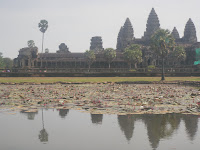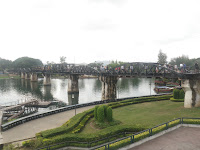
We really enjoyed our time here, but it's difficult not to be reflective about this country whose history is both brilliant, but also very tragic. We have high hopes for its future, and wish luck on this recovering country's journey. In fact, we're already seeing real signs of vitality. But first, the ancient history...
The Khmer people created a very prosperous empire - one which saw the creation of some of the world's greatest temples. While London, England had a struggling population of less than 50,000, the ancient city of Angkor already over a million citizens - many of whom were commissioned to build temples - the grand daddy of which is Angkor Wat...

We both really liked the temple Ta Promh. It has intentionally been left in the condition in which it was discovered by a French archaeologist in the 1920's. It has a real Indiana Jones feel to it.

But my favorite of all the temples was the Bayon. There are many four sided pillars, each with an enigmatic face carved onto each side.

Elsewhere in Angkor temples can be seen succumbing to slow but constant decay.

A common theme in the temple architecture are the extremely steep stairs...

Imagine the priests, arms loaded with offerings, trying to walk these stairs. Not for the feint of heart. That white speck at the bottom is Amanda.
In the end it was the Mongol hordes who saw to it that the Khmer didn't prosper longer than they should. Following rulers came and went, but the next big change didn't come until quite recently - 1974 to be exact. That's when an obscure dissident named Pol Pot led the rebel fighters (known as the Khmer Rouge) to seize control of the country. Immediately Pol Pot and the K.R. wrote one of the cruelest chapters in human history. Fed up with greed, corruption, and French imperialism, Pol Pot sought to isolate Cambodia and force it into one giant agrarian collective. The slightest reason to suspect that someone couldn't become an obedient farmer was reason enough to kill them. If you were a business owner, you were killed. If you were educated, you were killed. In fact, wearing eye glasses was a sure sign of intelligence, and often people were rounded up and tortured for just that.
Of the many concentration camps, S21, was formerly a high school in Phnom Penh.

Upwards of two million citizens were brought to places like these and tortured (often to death), in efforts to extract confessions of their crimes against the state. At its height, as many as 200 people a day were brought to this particular facility.

The K.R. documented each person they "processed", and with grim results...

Following their interrogation and confession, victims were brought from to a killing field. We went to one just outside of Phnom Penh. It was here we saw a mountain of skulls from the victims. This particular killing field saw the murder of around 20,000 people - men, women, and children, most of whom were killed by beatings from a shovel, hammer, axe, or other farm tool.

Children were also killed to ensure they could not avenge their parents' murders.
As if that wasn't enough, Cambodia did not escape the larger conflict going on in the area as USA and Russia waged their proxy war in South East Asia. Once all was said and done, the country had millions of landmines planted in its fields. Adults know not to stray from well marked paths, but children are not able to do as they're told, and many have been killed or lost legs and arms while playing in fields. In fact, to this day there are still many unexploded landmines in Cambodia, and many of the beggars we see are amputees.
Here is a group of landmine victims who play traditional Khmer music to raise money (instead of begging).

Cambodia is also known for its many devout Buddhist monks. Here's a couple nice monks who I spoke with while visiting the Royal Palace.

It seems they're not the only ones enjoying Cambodia's new found peace. Apparently Tin Tin has been getting "fish massages" while touring here!

Remember that picture from Thailand of the "non-toxic vegetables"? Here's Cambodia's version: no rat, cat, dog, monkey, or worm in their food. Good to know.

But what you can get is a delicious coconut-fish soup with flowers. Mmmmm.

Here are a couple nice pics from Cambodia's countryside (cleared of landmines).


And tomorrow we're off to Laos.









































